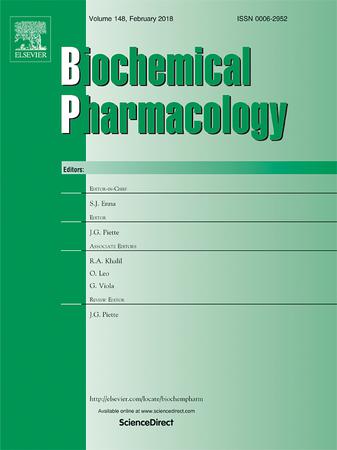An analysis of single-cell data reveals therapeutic effects of AMG487 in experimental autoimmune uveitis
IF 5.3
2区 医学
Q1 PHARMACOLOGY & PHARMACY
引用次数: 0
Abstract
Uveitis, an ocular autoimmune disease that poses a significant threat to vision, is caused by immune cells erroneously attacking retinal cells and currently lacks specific and effective therapeutic interventions. The CXC chemokine receptor 3 (CXCR3) facilitates the migration of immune cells to sites of inflammation. AMG487, a CXCR3 antagonist, holds potential for treating autoimmune diseases by blocking immunes cells chemotaxis. However, its effects and mechanisms in uveitis remain unclear. Using single-cell assay for transposase-accessible chromatin sequencing and RNA sequencing, we observed increased expression of CXCR3 and chemotactic pathways in peripheral blood of Vogt-Koyanagi-Harada patients and cervical lymph nodes of experimental autoimmune uveitis mice. AMG487 treatment in experimental autoimmune uveitis was shown to be therapeutically effective. Analysis of flow cytometry and single-cell RNA sequencing in AMG487-treated mice revealed reduced expression of inflammatory genes in immune cells. Specifically, AMG487 decreased the proportion of plasma cell in B cells, restored the ratio between effector T cells and regulatory T cells, and diminished T helper (Th) 17 cell pathogenicity by suppressing highly inflammatory granulocyte–macrophage colony-stimulating factor-producing Th17 cells while enhancing anti-inflammatory interleukin-10-producing Th17 cells. Our study presents an exhaustive single-cell transcriptional analysis of immune cells under AMG487 treatment, thereby elucidating potential mechanisms and providing a potential reference for the development of novel therapeutic strategies for autoimmune diseases.

单细胞数据分析揭示了AMG487在实验性自身免疫性葡萄膜炎中的治疗作用。
葡萄膜炎是一种严重威胁视力的眼部自身免疫性疾病,由免疫细胞错误地攻击视网膜细胞引起,目前缺乏特异性和有效的治疗干预措施。CXC趋化因子受体3 (CXCR3)促进免疫细胞向炎症部位的迁移。AMG487是一种CXCR3拮抗剂,具有通过阻断免疫细胞趋化性治疗自身免疫性疾病的潜力。然而,其在葡萄膜炎中的作用和机制尚不清楚。通过单细胞转座酶可及染色质测序和RNA测序,我们观察到Vogt-Koyanagi-Harada患者外周血和实验性自身免疫性葡萄膜炎小鼠颈部淋巴结中CXCR3和趋化途径的表达增加。AMG487治疗实验性自身免疫性葡萄膜炎显示出治疗效果。流式细胞术和单细胞RNA测序分析显示,amg487治疗小鼠免疫细胞中炎症基因的表达降低。具体而言,AMG487降低了B细胞中浆细胞的比例,恢复了效应T细胞和调节性T细胞的比例,并通过抑制高度炎症的粒细胞-巨噬细胞集落刺激因子产生的Th17细胞,同时增强抗炎的白细胞介素-10产生的Th17细胞,降低了辅助性T (Th) 17细胞的致病性。我们的研究对AMG487治疗下的免疫细胞进行了详尽的单细胞转录分析,从而阐明了潜在的机制,并为开发新的自身免疫性疾病治疗策略提供了潜在的参考。
本文章由计算机程序翻译,如有差异,请以英文原文为准。
求助全文
约1分钟内获得全文
求助全文
来源期刊

Biochemical pharmacology
医学-药学
CiteScore
10.30
自引率
1.70%
发文量
420
审稿时长
17 days
期刊介绍:
Biochemical Pharmacology publishes original research findings, Commentaries and review articles related to the elucidation of cellular and tissue function(s) at the biochemical and molecular levels, the modification of cellular phenotype(s) by genetic, transcriptional/translational or drug/compound-induced modifications, as well as the pharmacodynamics and pharmacokinetics of xenobiotics and drugs, the latter including both small molecules and biologics.
The journal''s target audience includes scientists engaged in the identification and study of the mechanisms of action of xenobiotics, biologics and drugs and in the drug discovery and development process.
All areas of cellular biology and cellular, tissue/organ and whole animal pharmacology fall within the scope of the journal. Drug classes covered include anti-infectives, anti-inflammatory agents, chemotherapeutics, cardiovascular, endocrinological, immunological, metabolic, neurological and psychiatric drugs, as well as research on drug metabolism and kinetics. While medicinal chemistry is a topic of complimentary interest, manuscripts in this area must contain sufficient biological data to characterize pharmacologically the compounds reported. Submissions describing work focused predominately on chemical synthesis and molecular modeling will not be considered for review.
While particular emphasis is placed on reporting the results of molecular and biochemical studies, research involving the use of tissue and animal models of human pathophysiology and toxicology is of interest to the extent that it helps define drug mechanisms of action, safety and efficacy.
 求助内容:
求助内容: 应助结果提醒方式:
应助结果提醒方式:


